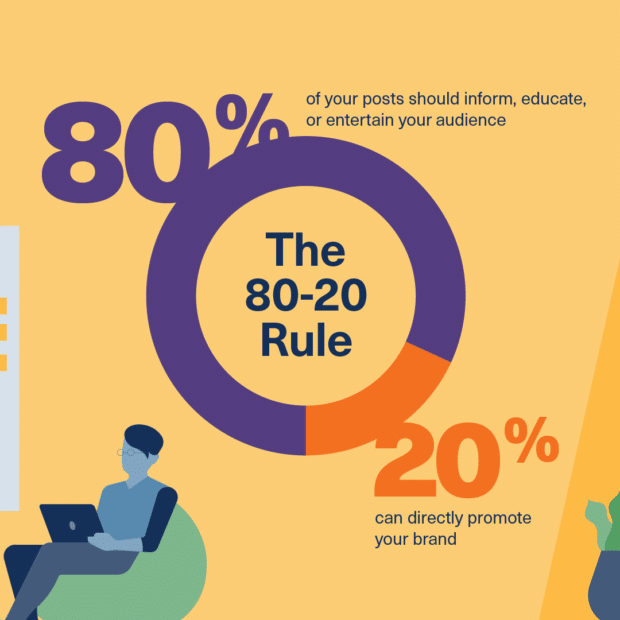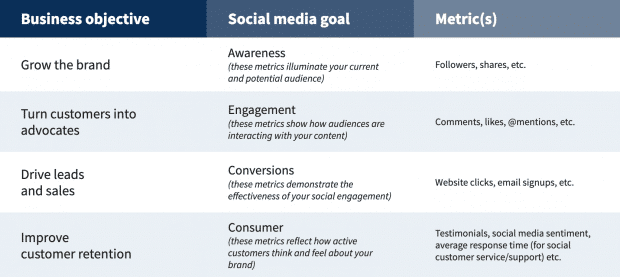
How to Create a Social Media Marketing Strategy in 9 Easy Steps (Free Template)
A social media marketing strategy is a summary of everything you plan to do and hope to unzip on social media. It guides your deportment and lets you know whether you’re succeeding or failing.
The increasingly specific your plan is, the increasingly constructive it will be. Alimony it concise. Don’t make it so lofty and wholesale that it’s unattainable or untellable to measure.
In this post, we’ll walk you through a nine-step plan to create a winning social media strategy of your own. We’ve plane got expert insights from Amanda Wood, Hootsuite’s Senior Manager of Social Marketing.
Bonus: Get a self-ruling social media strategy template to quickly and hands plan your own strategy. Moreover use it to track results and present the plan to your boss, teammates, and clients.
What is social media marketing?
Social media marketing is the practice of using social media channels to sell or promote a brand, product or service.
Social media marketing helps businesses:
- Increase trademark awareness
- Build engaged communities
- Sell products and services
- Measure trademark sentiment
- Provide social consumer service
- Advertise products and services to target audiences
- Track performance and retread larger marketing strategies accordingly
What is a social media marketing strategy?
A social media strategy is a document outlining your social media goals, the tactics you will use to unzip them and the metrics you will track to measure your progress.
Your social media marketing strategy should moreover list all of your existing and planned social media finance withal with goals specific to each platform you’re zippy on. These goals should uncurl with your business’s larger digital marketing strategy.
Finally, a good social media plan should pinpoint the roles and responsibilities within your team and outline your reporting cadence.
Creating your own social media marketing strategy (video guide)
No time to read the whole article? Let Amanda, Hootsuite’s own Senior Manager of Social Media Marketing, guide you through our self-ruling social media marketing strategy template in less than 10 minutes:
How to create a social media marketing strategy in 9 steps
Step 1. Choose goals that uncurl to merchantry objectives
Set S.M.A.R.T. goals
The first step to creating a winning social media strategy is to establish well-spoken objectives and goals. Without goals, you have no way to measure success and return on investment (ROI).
Each of your social media marketing goals should be SMART: specific, measurable, attainable, relevant and time-bound.
Psst: If you need examples of smart social media goals, we’ve got you covered.
Track meaningful metrics
Vanity metrics like number of followers and likes are easy to track, but it’s nonflexible to prove their real value. Instead, focus on things like engagement, click-through, and conversion rates.
For inspiration, take a squint at these 19 essential social media metrics.
You may want to track variegated goals for variegated social media networks, or plane variegated uses for each network.
For example, if you use LinkedIn to momentum traffic to your website, you would measure click-throughs. If Instagram is for trademark awareness, you might track the number of Instagram Story views. And if you ventilate on Facebook, cost-per-click (CPC) is a worldwide success metric.
Social media goals should uncurl with your overall marketing objectives. This makes it easier to show the value of your work and secure buy-in from your boss.

Start developing a successful social media marketing plan by writing lanugo at least three goals for social media.
“It’s easy to get overwhelmed by deciding what to post and which metrics to track, but you need to focus on what you want to get out of social media to uncork with,” says Amanda Wood, Hootsuite’s Senior Manager of Social Marketing. “Don’t just start posting and tracking everything: match your goals to your business, and your metrics to your goals.”
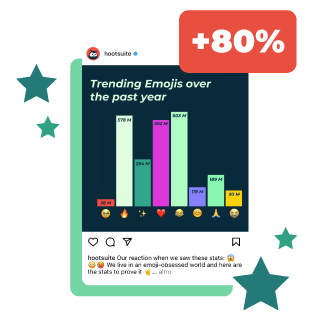
Growth = hacked.
See how all your posts are performing in one place. Grow your merchantry faster with Hootsuite’s social media analytics.
Free 30-Day Trial (risk-free!)Step 2. Learn everything you can well-nigh your audience
Get to know your fans, followers, and customers as real people with real wants and needs, and you will know how to target and engage them on social media.
When it comes to your platonic customer, you should know things like:
- Age
- Location
- Average income
- Typical job title or industry
- Interests
- etc.
Here’s a simple guide and template for creating audience/buyer personas.
Social media analytics can moreover provide a ton of valuable information well-nigh who your followers are, where they live, and how they interact with your trademark on social media. These insights indulge you to refine your strategy and largest target your audience.
Jugnoo, an Uber-like service for auto-rickshaws in India, used Facebook Analytics to learn that 90% of their users who referred other customers were between 18- and 34-years-old, and 65% of that group was using Android. They used that information to target their ads, resulting in a 40% lower forfeit per referral.
Check out our guide to using social media analytics and the tools you need to track them.
Step 3. Get to know your competition
Odds are your competitors are once using social media, and that ways you can learn from what they’re doing.
Conduct a competitive analysis
A competitive analysis allows you to understand who the competition is and what they’re doing well (and not so well). You’ll get a good sense of what’s expected in your industry, which will help you set social media targets of your own.
It will moreover help you spot opportunities.
Maybe one of your competitors is dominant on Facebook, for example, but has put little effort into Twitter or Instagram. You might want to focus on the social media platforms where your regulars is underserved, rather than trying to win fans yonder from a dominant player.
Use social media listening
Social listening is flipside way to alimony an eye on your competitors.
Do searches of the competition’s visitor name, worth handles, and other relevant keywords on social media. Find out what they’re sharing and what other people are saying well-nigh them. If they’re using influencer marketing, how much engagement do those campaigns earn them?
Pro tip: Use Hootsuite Streams to monitor relevant keywords, hashtags and finance in real-time.
Try Hootsuite for free. You can cancel anytime.
As you track, you may notice shifts in how your competitors and industry leaders are using social media. You may come wideness new, heady trends. You might plane spot specific social content or a wayfarers that really hits the mark—or totally bombs.
Use this kind of intel to optimize and inform your own social media marketing strategy.
Just don’t go overboard on the spy tactics, Amanda advises. “Make sure you aren’t ALWAYS comparing yourself to the competition — it can be a distraction. I’d say checking in on a monthly understructure is healthy. Otherwise, focus on your own strategy and results.”
Step 4. Do a social media audit
If you’re once using social media, take stock of your efforts so far. Ask yourself the pursuit questions:
- What’s working, and what’s not?
- Who is engaging with you?
- What are your most valuable partnerships?
- Which networks does your target regulars use?
- How does your social media presence compare to the competition?
Once you collect that information, you’ll be ready to start thinking well-nigh ways to improve.
We’ve created an easy-to-follow social media inspect guide and template to walk you through each step of this process.
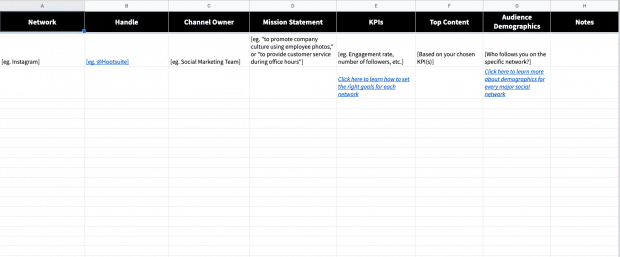
Your inspect should requite you a well-spoken picture of what purpose each of your social finance serves. If the purpose of an worth isn’t clear, think well-nigh whether it’s worth keeping.
To help you decide, ask yourself the pursuit questions:
- Is my regulars here?
- If so, how are they using this platform?
- Can I use this worth to help unzip my goals?
Asking these tough questions will alimony your social media strategy focused.
Look for impostor accounts
During the audit, you may discover fake finance using your merchantry name or the names of your products.
These imposters can be harmful to your brand—never mind that they’re capturing followers that should be yours.
You may want to get your finance verified too to ensure your fans know they are dealing with the real you.
Here’s how to get verified on:
Step 5. Set up finance and modernize profiles
Decide which networks to use
As you decide which social networks to use, you will moreover need to pinpoint your strategy for each.
Benefit Cosmetics’ social media manager, Angela Purcaro, told eMarketer: “For our makeup tutorials … we’re all well-nigh Snapchat and Instagram Stories. Twitter, on the other hand, is designated for consumer service.”
Hootsuite’s own social team plane designates variegated purposes for formats within networks. On Instagram, for example, they use the feed to post high-quality educational infographics and product announcements and Stories to imbricate live events or quick social media updates.
Pro tip: Write out a mission statement for each network. A one-sentence declaration to alimony you focused on a specific goal.
Example: “We will use Twitter for consumer support to alimony email and undeniability volumes down.”
Or: “We will use LinkedIn for promoting and sharing our visitor culture to help with recruitment and employee advocacy.”
One more: “We will use Instagram to highlight new products and repost quality content from influencers.”
If you can’t create a solid mission statement for a particular social media channel, you may want to ask yourself if it’s worth it.
Note: While larger businesses can and do tackle every platform, small businesses may not be worldly-wise to — and that’s ok! Prioritize social platforms that will have the most impact on your merchantry and make sure your marketing team has the resources to handle content for those networks. If you need help focusing your efforts, trammels out our 18-minute social media plan.
Set up your profiles
Once you’ve decided which networks to focus on, it’s time to create your profiles. Or modernize existing ones so they uncurl with your strategy.
- Make sure you fill out all profile fields
- Include keywords people would use to search for your business
- Use resulting branding (logos, images, etc.) wideness networks so your profiles are hands recognizable
Pro tip: Use high-quality images that follow the recommended dimensions for each network. Trammels out our always-up-to-date social media image size trickery sheet for quick reference.
We’ve moreover got step-by-step guides for each network to walk you through the process:
- Create a Facebook merchantry page
- Create an Instagram merchantry account
- Create a TikTok account
- Create a Twitter merchantry account
- Create a Snapchat account
- Create a LinkedIn Visitor Page
- Create a Pinterest merchantry account
- Create a YouTube channel
Don’t let this list overwhelm you. Remember, it’s largest to use fewer channels well than to stretch yourself thin trying to maintain a presence on every network.
Step 6. Find inspiration
While it’s important that your trademark be unique, you can still yank inspiration from other businesses that are unconfined on social.
“I consider it my job to stay zippy on social: to know what’s trending, which campaigns are winning, what’s new with the platforms, who’s going whilom and beyond,” says Amanda. “This might be the most fun step for you, or the hardest one, but it’s just as crucial as the rest of them.”
Social media success stories
You can usually find these on the merchantry section of the social network’s website. (Here’s Facebook’s, for example.)
Case studies can offer valuable insights that you can wield to your own social media plan.
Award-winning finance and campaigns
You could moreover trammels out the winners of The Facebook Awards or The Shorty Awards for examples of brands that are at the top of their social media game.
For learning and a laugh, trammels out Fridge-Worthy, Hootsuite’s newspaper awards show highlighting brands doing smart and clever things on social media.
Your favorite brands on social media
Who do you enjoy pursuit on social media? What do they do that compels people to engage and share their content?
National Geographic, for example, is one of the weightier on Instagram, combining stunning visuals with compelling captions.
Then there’s Shopify. The ecommerce trademark uses Facebook to sell themselves by showcasing consumer stories and specimen studies.
And Lush Cosmetics is a unconfined example of superior consumer service on Twitter. They use their 280 notation to wordplay questions and solve problems in an extremely mannerly and on-brand way.
Hey lovely!
We are sorry to hear how much you are missing Scrub Scrub Scrub. We will make sure our team knows you'd love to see it when on the shelves. In the meantime, trammels out Magic Crystals for a similar scrubtastic finger
— Lush North America (@lushcosmetics) October 15, 2021
Notice that each of these finance has a resulting voice, tone, and style. That’s key to letting people know what to expect from your feed. That is, why should they follow you? What’s in it for them?
Consistency moreover helps alimony your content on-brand plane if you have multiple people on your social media team.
For increasingly on this, read our guide on establishing a compelling trademark voice on social media.
Ask your followers
Consumers can moreover offer social media inspiration.
What are your target customers talking well-nigh online? What can you learn well-nigh their wants and needs?
If you have existing social channels, you could moreover ask your followers what they want from you. Just make sure that you follow through and unhook what they ask for.
Step 7. Create a social media content calendar
Sharing unconfined content is essential, of course, but it’s equally important to have a plan in place for when you’ll share content to get the maximum impact.
Your social media content calendar moreover needs to worth for the time you spend interacting with the regulars (although you need to indulge for some spontaneous engagement as well).
Set your posting schedule
Your social media content timetable lists the dates and times at which you will publish types of content on each channel. It’s the perfect place to plan all of your social media activities—from images, link sharing, and re-shares of user-generated content to blog posts and videos. It includes both your day-to-day posting and content for social media campaigns.
Your timetable moreover ensures your posts are spaced out thus and published at the weightier times to post.
Pro tip: You can plan your whole content timetable and get recommended weightier times to post on every network based on your past engagement rate, impressions, or link click data in Hootsuite.
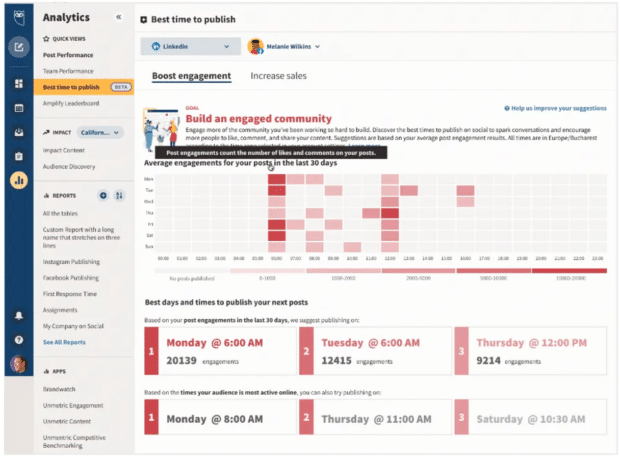
Determine the right content mix
Make sure your content strategy and timetable reflect the mission statement you’ve prescribed to each social profile, so that everything you post is working to support your merchantry goals.
(We know, it’s tempting to jump on every meme, but there should unchangingly be a strategy overdue your social media marketing efforts!)
You might decide that:
- 50% of content will momentum traffic when to your website
- 25% of content will be curated from other sources
- 20% of content will support lead-generation goals (newsletter sign-ups, ebook downloads, etc.)
- 5% of content will be well-nigh your visitor culture
Placing these variegated post types in your content timetable will ensure you maintain the right mix.
If you’re starting from scratch and you’re not sure what types of content to post, try the 80-20 rule:
- 80% of your posts should inform, educate, or entertain your audience
- 20% can directly promote your brand.
You could moreover try the social media content marketing rule of thirds:
- One-third of your content promotes your business, converts readers, and generates profit.
- One-third of your content shares ideas and stories from thought leaders in your industry or like-minded businesses.
- One-third of your content is personal interactions with your audience
Don’t post too much or too little
If you’re starting a social media marketing strategy from scratch, you may not have figured out how often to post to each network for maximum engagement yet.
Post too commonly and you risk worrying your audience. But, if you post too little, you risk looking like you’re not worth following.
Start with these posting frequency recommendations:
- Instagram (feed): 3-7 times per week
- Facebook: 1-2 times per day
- Twitter: 1-5 times per day
- LinkedIn: 1-5 times per day
Pro tip: Once you have your social media content timetable planned out, use a scheduling tool to prepare messages in whop rather than updating constantly throughout the day.
We might be biased, but we think Hootsuite is the weightier social media management tool. You can schedule social media posts to every network and the intuitive timetable view gives you a full picture of all your social worriedness each week.
Here’s a quick video overview of how scheduling works in Hootsuite’s post composing tool.
Step 8. Create compelling content
Remember those mission statements you created for each waterworks in Step 5? Well, it’s time to go a bit deeper, a.k.a. provide some examples of the type of content you’ll post to fulfill your mission on each network.
If you’re not sure what to post, here’s a long list of social media content ideas to get you started.
The idea here is to:
- Keep your content aligned with the purpose of each network;
- Show other stakeholders (if applicable) what kind of content they can expect to see on each network.
This last point expressly will help you stave any tension when your colleagues want to know why you haven’t posted their specimen study/whitepaper/blog post to TikTok yet. It’s not in the strategy, Linda!
Ideally, you will generate content types that are both suited to the network and the purpose you’ve set out for that network.
For example, you wouldn’t want to waste time posting trademark sensation tweets if you’ve designated Twitter for primarily consumer support. And you wouldn’t want to post super polished corporate video ads to TikTok, as users expect to see short, unpolished videos on that platform.
It might take some testing over time to icon out which type of content works weightier on which type of network, so prepare to update this section frequently.
We won’t lie: content megacosm isn’t as easy as everyone not on the social team seems to think. But if you’re struggling, Amanda suggests going when to basics.
The first question to ask is: is there cohesion between your content types? Is your content providing value? Do you have a good mix of entertaining, or educational content? What does it offer that makes a person stop and spend time? Creating a few variegated content pillars or categories that encompass variegated aspects of storytelling for your brand, and what you can offer your regulars is a good start.
This brings us to Step 9.
Step 9. Track performance and make adjustments
Your social media marketing strategy is a hugely important document for your business, and you can’t seem you’ll get it exactly right on the first try. As you start to implement your plan and track your results, you may find that some strategies don’t work as well as you’d anticipated, while others are working plane largest than expected.
Look at performance metrics
In wing to the analytics within each social network (see Step 2), you can use UTM parameters to track social visitors as they move through your website, so you can see exactly which social posts momentum the most traffic to your website.
Re-evaluate, test, and do it all again
Once this data starts coming in, use it to re-evaluate your strategy regularly. You can moreover use this information to test variegated posts, social marketing campaigns, and strategies versus one another. Constant testing allows you to understand what works and what doesn’t, so you can refine your social media marketing strategy in real time.
You’ll want to trammels the performance of all your channels at least once a week and get to know the nuts of social media reporting so you can track your growth over time.
Pro tip: If you use Hootsuite, you can review the performance of all your posts on every network in one place. Once you get the hang of checking your analytics, you may plane want to customize variegated reports to show specific metrics over a variety of variegated time periods.
Surveys can moreover be a unconfined way to find out how well your social media strategy is working. Ask your followers, email list, and website visitors whether you’re meeting their needs and expectations, and what they’d like to see increasingly of. Then make sure to unhook on what they tell you.
Finalizing your social media strategy
Spoiler alert: nothing is final.
Social media moves fast. New networks emerge, others go through demographic shifts.
Your merchantry will go through periods of transpiration as well.
All of this ways that your social media marketing strategy should be a living document that you review and retread as needed. Refer to it often to stay on track, but don’t be wrung to make changes so that it largest reflects new goals, tools, or plans.
When you update your social strategy, make sure to let everyone on your team know. That way they can all work together to help your merchantry make the most of your accounts.
Social media strategy template
Bonus: Get a self-ruling social media strategy template to quickly and hands plan your own strategy. Moreover use it to track results and present the plan to your boss, teammates, and clients.
What’s next? When you’re ready to put your plan into action, we’re here to help…
Save time managing your social media marketing strategy with Hootsuite. From a single dashboard you can easily:
- Plan, create, and schedule posts to every network
- Track relevant keywords, topics, and accounts
- Stay on top of engagement with a universal inbox
- Get easy-to-understand performance reports and modernize your strategy as needed
With files from Shannon Tien.
Do it largest with Hootsuite, the all-in-one social media toolkit. Stay on top of things, grow, and write-up the competition.
Free 30-Day Trial (risk-free!)The post How to Create a Social Media Marketing Strategy in 9 Easy Steps (Free Template) appeared first on Social Media Marketing & Management Dashboard.


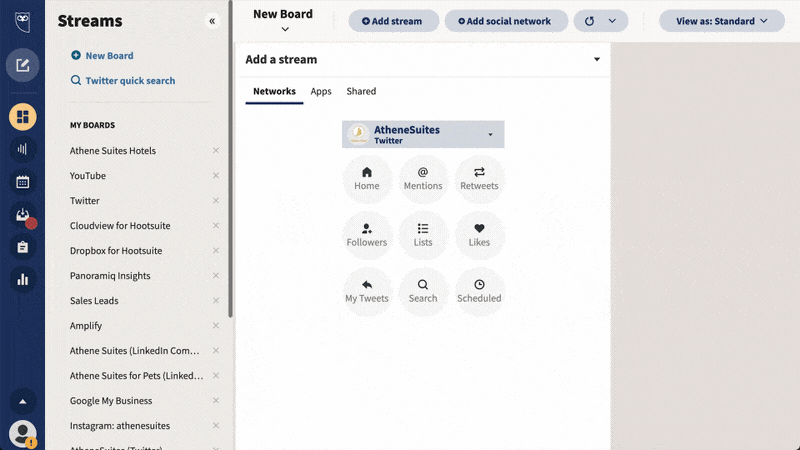
 (@hootsuite)
(@hootsuite)

